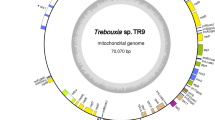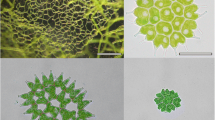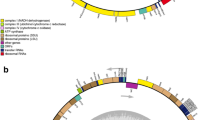Abstract
The first two mitochondrial genomes of marine diatoms were previously reported for the centric Thalassiosira pseudonana and the raphid pennate Phaeodactylum tricornutum. As part of a genomic project, we sequenced the complete mitochondrial genome of the freshwater araphid pennate diatom Synedra acus. This 46,657 bp mtDNA encodes 2 rRNAs, 24 tRNAs, and 33 proteins. The mtDNA of S. acus contains three group II introns, two inserted into the cox1 gene and containing ORFs, and one inserted into the rnl gene and lacking an ORF. The compact gene organization contrasts with the presence of a 4.9-kb-long intergenic region, which contains repeat sequences. Comparison of the three sequenced mtDNAs showed that these three genomes carry similar gene pools, but the positions of some genes are rearranged. Phylogenetic analysis performed with a fragment of the cox1 gene of diatoms and other heterokonts produced a tree that is similar to that derived from 18S RNA genes. The introns of mtDNA in the diatoms seem to be polyphyletic. This study demonstrates that pyrosequencing is an efficient method for complete sequencing of mitochondrial genomes from diatoms, and may soon give valuable information about the molecular phylogeny of this outstanding group of unicellular organisms.



Similar content being viewed by others
Abbreviations
- ORF:
-
Open reading frame
- RT:
-
Reverse transcriptase
- ML:
-
Maximum likelihood
- BA:
-
Bayesian analysis
- RT:
-
Reverse transcriptase
References
Adams KL, Palmer JD (2003) Evolution of mitochondrial gene content: gene loss and transfer to the nucleus. Mol Phylogenet Evol 29:380–395
Altschul SF, Madden TL, Schaffer AA, Zhang J, Zhang Z, Miller W, Lipman DJ (1997) Gapped BLAST and PSI-BLAST: new generation of protein database search programs. Nucleic Acids Res 25:3389–3402
Alverson AJ (2008) Molecular systematics and the diatom species. Protist 159:339–353
Andersen RA (2004) Biology and systematics of heterokont and haptophyte algae. Am J Bot 91:1508–1522
Andersson SGE, Zomorodipour A, Andersson JO, Sicheritz-Pontén T, Alsmark UCM, Podowski RM, Näslund AK, Eriksson AS, Winkler HH, Kurland CG (1998) The genome sequence of Rickettsia prowazekii and the origin of mitochondria. Nature 396:133–140
Andersson SG, Karlberg O, Canback B, Kurland CG (2003) On the origin of mitochondria: a genomics perspective. Philos Trans R Soc Lond B Biol Sci 358:165–177
Armbrust EV, Berges JA, Bowler C, Green BR, Martinez D, Putnam NH, Zhou S, Allen AE, Apt KE, Bechner M, Brzezinski MA, Chaal BK, Chiovitti A, Davis AK, Demarest MS, Detter JC, Glavina T, Goodstein D, Hadi MZ, Hellsten U, Hildebrand M, Jenkins BD, Jurka J, Kapitonov VV, Kröger N, Lau WW, Lane TW, Larimer FW, Lippmeier JC, Lucas S, Medina M, Montsant A, Obornik M, Parker MS, Palenik B, Pazour GJ, Richardson PM, Rynearson TA, Saito MA, Schwartz DC, Thamatrakoln K, Valentin K, Vardi A, Wilkerson FP, Rokhsar DS (2004) The genome of the diatom Thalassiosira pseudonana: ecology, evolution, and metabolism. Science 306:79–86
Bowler C, Allen AE, Badger JH, Grimwood J, Jabbari K, Kuo A, Maheswari U, Martens C, Maumus F, Otillar RP, Rayko E, Salamov A, Vandepoele K, Beszteri B, Gruber A, Heijde M, Katinka M, Mock T, Valentin K, Verret F, Berges JA, Brownlee C, Cadoret JP, Chiovitti A, Choi CJ, Coesel S, De Martino A, Detter JC, Durkin C, Falciatore A, Fournet J, Haruta M, Huysman MJ, Jenkins BD, Jiroutova K, Jorgensen RE, Joubert Y, Kaplan A, Kröger N, Kroth PG, La Roche J, Lindquist E, Lommer M, Martin-Jézéquel V, Lopez PJ, Lucas S, Mangogna M, McGinnis K, Medlin LK, Montsant A, Oudot-Le Secq MP, Napoli C, Obornik M, Parker MS, Petit JL, Porcel BM, Poulsen N, Robison M, Rychlewski L, Rynearson TA, Schmutz J, Shapiro H, Siaut M, Stanley M, Sussman MR, Taylor AR, Vardi A, von Dassow P, Vyverman W, Willis A, Wyrwicz LS, Rokhsar DS, Weissenbach J, Armbrust EV, Green BR, Van de Peer Y, Grigoriev IV (2008) The Phaeodactylum genome reveals the evolutionary history of diatom genomes. Nature 456:239–244
Bullerwell CE, Gray MW (2004) Evolution of the mitochondrial genome: protist connections to animals, fungi and plants. Curr Opin Microbiol 7:528–534
Burger G, O’Kelly C, Gray MW, Lang DF (2000) Thraustochytrium aureum mitocholdrial DNA, partial sequence. OGMP: GenBank access. no. AF288091
Ehara M, Inagaki Y, Watanabe KI, Ohama T (2000) Phylogenetic analysis of diatom coxI genes and implications of a fluctuating GC content on mitochondrial genetic code evolution. Curr Genet 37:29–33
Emelyanov VV (2001) Evolutionary relationship of rickettsiae and mitochondria. FEBS Lett 501:11–18
Emelyanov VV (2003) Common evolutionary origin of mitochondrial and rickettsial respiratory chains. Arch Biochem Biophys 420:130–141
Funk DJ, Omland KE (2003) Species-level paraphyly and polyphyly: frequency, causes, and consequences, with insights from animal mitochondrial DNA. Annu Rev Ecol Evol Syst 34:397–423
Gray MW, Burger G, Lang BF (1999) Mitochondrial evolution. Science 283:1476–1481
Gray MW, Lang BF, Burger G (2004) Mitochondria of protists. Annu Rev Genet 38:477–524
Guindon S, Gascuel O (2003) A simple, fast, and accurate algorithm to estimate large phylogenies by maximum likelihood. Syst Biol 52:696–704
Hauth AM, Joseph DA (2002) Beyond tandem repeats: complex pattern structures and distant regions of similarity. Bioinformatics 1(Suppl):S31–S37
Hauth AM, Maier UG, Lang BF, Burger G (2005) The Rhodomonas salina mitochondrial genome: bacteria-like operons, compact gene arrangement and complex repeat region. Nucleic Acids Res 33:4433–4442
Imanian B, Carpenter KJ, Keeling PJ (2007) Mitochondrial genome of a tertial endosymbiont retains genes for electron transport proteins. J Eukaryot Microbiol 54:146–153
Jacobs JD, Ludwig JR, Hildebrand M, Kukel A, Feng T-Y, Ord RW, Volcani BE (1992) Characterization of two circular plasmids from the marine diatom Cylindrotheca fusiformis: plasmids hybridize to chloroplast and nuclear DNA. Mol Gen Genet 233:302–310
Jobb G, von Haeseler A, Strimmer K (2004) TREEFINDER: a powerful graphical analysis environment for molecular phylogenetics. BMC Evol Biol 4:18
Kamikawa R, Masuda I, Demura M, Oyama K, Yoshimatsu S, Kawachi M, Sako Y (2009) Mitochondrial group II introns in the raphidophycean flagellate Chattonella spp. suggest a diatom-to-Chattonella lateral group II intron transfer. Protist 160:364–375
Kim E, Lane CE, Curtis BA, Kozera C, Bowman S, Archibald JM (2008) Complete sequence and analysis of the mitochondrial genome of Hemiselmis andersenii CCMP644 (Cryptophyceae). BMC Genomics 9:215
Kooistra WH, De Stefano M, Mann DG, Medlin LK (2003) The phylogeny of the diatoms. Prog Mol Subcell Biol 33:59–97
Krzywinski M, Schein J, Birol I, Connors J, Gascoyne R, Horsman D, Jones SJ, Marra MA (2009) Circos: an information aesthetic for comparative genomics. Genome Res 19:1639–1645
Lambowitz AM, Zimmerly S (2004) Mobile group II introns. Annu Rev Genet 38:1–35
Lang BF, Gray MW, Burger G (1999) Mitochondrial genome evolution and the origin of eukaryotes. Annu Rev Genet 33:351–397
Le SQ, Gascuel O (2008) An improved general amino acid replacement matrix. Mol Biol Evol 25:1307–1320
Levinson G, Gutman GA (1987) Slipped-strand mispairing: a major mechanism for DNA sequence evolution. Mol Biol Evol 4:203–221
Lowe TM, Eddy SR (1997) tRNAscan-SE: a program for improved detection of transfer RNA genes in genomic sequence. Nucleic Acids Res 25:955–964
Mann DG (1994) The origins of shape and form in diatoms: the interplay between morphogenetic studies and systematics. In: Ingram DS, Hudson AJ (eds) Shape and form in plants and fungi. Academic Press, London, pp 17–38
Medlin LK (2009) Diatom (Bacillariophyta). In: Hedges SB, Kuman S (eds) The timetree of life. Oxford University Press, pp 127–130
Medlin LK, Kaczmarska I (2004) Evolution of the diatoms: morphological and cytological support for the major clades and a taxonomic revision. Phycologia 43:245–270
Michel F, Ferat J-L (1995) Structure and activities of group II introns. Annu Rev Biochem 64:435–461
Posada D (2008) jModelTest: phylogenetic model averaging. Mol Biol Evol 25:1253–1256
Rochaix J-D, Mayfield S, Goldschmidt-Clermont M, Erickson J (1988) Molecular biology of Chlamydomonas. In: Shaw CH (ed) Plant molecular biology: a practical approach. IRL Press, Oxford, pp 253–275
Round FE (1996) What characters define diatom genera, species and infra-specific taxa? Diatom Res 11:203–218
Thompson AS, Rhodes JC, Pettman I (eds) (1988) Culture collections of algae and protozoa. Titus Wilson & Son, Kendal
Vereshchagin AL, OYu Glyzina, Basharina TN, Safonova TA, Latyshev NA, Liubochko SA, Korneva ES, Petrova DP, Annenkov VV, Danilovtseva EN, Chebykin EP, Volokitina NA, Grachev MA (2008) Culturing of a fresh-water diatom alga Synedra acus in a 100 L photobioreactor and analysis of the biomass composition. Biotekhnologia 4:55–63
Wernersson R, Pedersen AG (2003) RevTrans—constructing alignments of coding DNA from aligned amino acid sequences. Nucleic Acids Res 31:3537–3539
Acknowledgments
We are grateful to Dr Chris Bowler for granting access to the P. tricornutum mtDNA sequence and to Dr Ryoma Kamikawa for the kindly presented alignment of RT domain sequences of group II introns. This work was financially supported by the Program of the Presidium of the Russian Academy of Sciences “Molecular and Cell Biology” (project # 22.3) and by the Federal Agency for Science and Innovations of Russia (contract 02.552.11.7045).
Author information
Authors and Affiliations
Corresponding author
Additional information
Communicated by D. Stern.
Rights and permissions
About this article
Cite this article
Ravin, N.V., Galachyants, Y.P., Mardanov, A.V. et al. Complete sequence of the mitochondrial genome of a diatom alga Synedra acus and comparative analysis of diatom mitochondrial genomes. Curr Genet 56, 215–223 (2010). https://doi.org/10.1007/s00294-010-0293-3
Received:
Revised:
Accepted:
Published:
Issue Date:
DOI: https://doi.org/10.1007/s00294-010-0293-3




